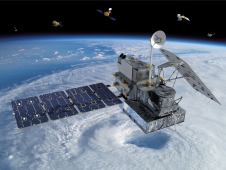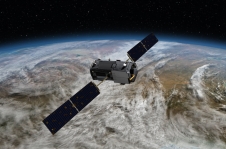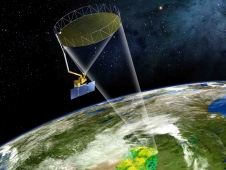Although NASA still has its
sights on Mars and beyond, this is the "year of the
Earth," they say. For the first time in more than a decade, NASA will launch five scientific missions in the same calendar year
– all focused on our planet’s "vital signs."
NASA will collect
much-needed data about the state of the Earth and how it is changing: precise calculations of
carbon dioxide in the atmosphere; global rainfall and snow patterns;
particulate pollution and the amount of water in the soil. Scientists are taking the introspective missions to help identify answers to the critical
challenges facing our planet.
Mission 1: Global
Precipitation Measurement (GPM) Observatory

Launching on February 27, this collaborative effort with the Japan
Aerospace Exploration Agency (JAXA), will use satellites to make – for the first time – nearly global
observations of rainfall and snowfall. It will help answer questions about our planet’s
life-sustaining water cycle, and improve water resource management and weather
forecasting.
Mission 2: Orbiting Carbon
Observatory

Scheduled for July, this satellite will make precise, global
measurements of the amount of carbon dioxide in the atmosphere. The
goal is to advance our understanding of carbon’s role in climate change and how these emissions cycle through Earth’s
oceans, land and atmosphere.
Mission 3: Soil Moisture
Active Passive (SMAP) mission

Planned for November, a satellite will map Earth’s soil moisture to improve understanding of the cycling of water, energy, and carbon.
SMAP data will be used to construct high-resolution
global maps of soil moisture that can inform water resource management decisions across the world and aid in predictions of plant growth and agricultural productivity, weather and climate forecasts, floods and droughts.
"On our home planet
Earth, water is an essential requirement for life and for most human
activities. We must understand the details of how water moves within and
between the atmosphere, the oceans, and the land if we are to predict changes
to our climate and the availability of water resources," says Michael
Freilich, director of NASA’s Earth Science Division.
"Coupled with data from other ongoing NASA missions that measure
sea-surface salinity and that detect changes in underground aquifer levels,
with GPM and SMAP we will have unprecedented measurements of our planet’s vital
water cycle."
Missions 4 and 5:
International Space Station
NASA will also make two missions to the International
Space Station to measure ocean winds, clouds, and aerosols in the
atmosphere.
Even though International Space Station can monitor nearly 85% of
Earth’s surface, this will be the first time NASA uses it as an
Earth observation platform. Going forward, it will routinely observe Earth 24 hours a day.
In June, it will study patterns of ocean wind circulation around the world that are crucial to climate research and tracking hurricanes and other storms.
In September, NASA will observe how small particles move in the atmosphere from air pollution, volcanic ash, dust and smoke. These aerosol particulates post human health risks and influence global climate through their
impact on cloud cover and solar radiation in Earth’s atmosphere.
"The International Space Station will come into its own as an important
platform for studying the Earth system and global change," says Julie
Robinson, space station chief scientist at NASA’s Johnson Space Center. "This is just the beginning of the space station becoming a part
of the global Earth-observing network."
NASA also uses a wide array of research aircraft equipped with sophisticated
sensors to advance Earth science research. This year, 12
flight campaigns will study the polar ice sheets, urban air pollution,
hurricanes, ecosystem health and more over the US, Central and South
America, Antarctica, and the Arctic Circle.
Read our article, NASA Unfurls Solar Sail in Space.
Learn more at NASA’s website:
